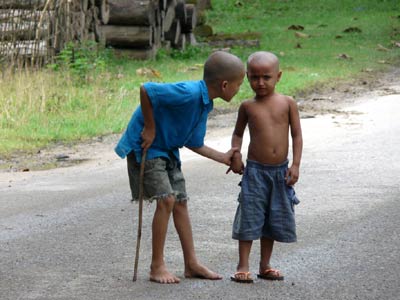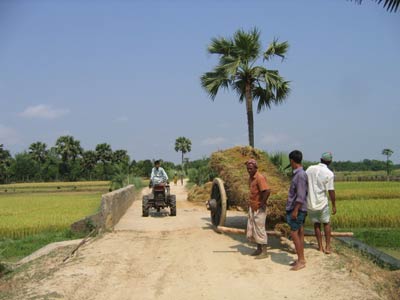 |
Chiara Bianchizza describes how perception, power and participation are crucial ingredients in reducing vulnerability to climate change in Bangladesh. |
| Social and human resources have increased the resilience to climate change of vulnerable communities in Bangladesh. The author describes how non-government organizations work to build community capacity, and promotes approaches that give communities tools to identify issues and solutions themselves. She concludes by underlining the importance of strong social networks and gender equality in building capacity and securing resilience. | |
| The author is a researcher at the Institute of International Sociology Gorizia in Italy. She is currently working on social capacity building for natural hazards in Europe. | |
Adapting to the changing climate is a priority for the rural poor, who see their traditional livelihood systems increasingly challenged by modified climatic patterns. Bangladesh is particularly vulnerable to climate-related hazards and its rural populations are amongst the poorest in the world. This article focuses on how poor, rural Bangladeshi communities, highly exposed to natural hazards, can increase their resilience and reduce their vulnerability to climate change.
Capacity building is more effective when conducted using bottom-up approaches. This article, therefore, concentrates on the role played by assets already owned by communities. These assets are human (knowledge, perception, awareness of individuals) and social (networks, relations, institutions).
Research methods and results
The article is based on research analysing the agricultural knowledge of, and changes experienced by, six case study communities exposed to different climate change-related hazards in four districts of Bangladesh. Findings are based on qualitative research methods including semi-structured interviews, focus group discussions and direct field observations. Information gathered on agricultural and environmental knowledge, perceptions about climatic change, social organization and non-government organization (NGO) intervention in the communities were summarized in a SWOT analysis. This looks at the internal strengths (S) and weaknesses (W) of a community and the opportunities (O) and threats (T) provided by external interventions.
The table below shows the results of these strengths, weaknesses, opportunities and threats observed in some or all of the six different sites of Dacope, Nowapara, Kundarpara, Bajechitulia, Goripur and Vag Parul.
| Agricultural and environmental knowledge, climate change perceptions and local organization in six communities | ||
|---|---|---|
|
Perceptions, power and participation
Case study analysis shows that the communities' perception of a threat shapes how they react to it. Some communities have no access to climate change-related information. Climatic variation is attributed to God's will or to mismanagement of resources by decision makers. It is thus perceived as something unchangeable and for which no solution can be found. The fact that farmers cannot access relevant information severely limits the ability of the community to develop its social strength. As a result, people abandon their traditional livelihood systems.
 |
| Boys in Bangladesh |
Other communities, although trained by NGOs about climate change-related hazards and, therefore, with access to more information, still have little understanding of the knowledge they have been exposed to. This is because they lack a basic formal education, which would help them make sense of this information. At the same time, they show a deep understanding of natural phenomena, explanations for which are rooted in tradition knowledge. As the climate changes, this type of knowledge will be lost as it is inadequate for explaining the modified environmental conditions. A community involved in a research project will autonomously gain information about climate change and will thus understand its dynamics and the fact that it creates a trend that will continue to modify and challenge livelihoods. This knowledge has allowed farmers to react to current changes in their environment, but also to prepare and build resilience for the future.
Different communities and different community members have variable levels of empowerment and participation in decision making as a result of the range of perceptions and possibilities for accessing information about climate change. Two village cases illustrate the different conditions that women live under. In one, women are generally kept strictly under men's rule and in ignorance of things that "women do not need to know". Information is thus locked in "gender-boxes". Women have different priorities for household organization and activities, so this gender-boxing of information impairs the ability of the community to build its social strength. Gender-differentiated approaches to environmental issues become impossible because women cannot fully participate in society, even though this would increase community resilience to climate-related hazards.
In other communities where women are more independent, where they participate in agricultural activities and contribute actively to increasing household income and investing in their children's education, community resilience is greater. Here, the empowerment and active social participation of women helps build community capacity.
The other socially significant factor that differentiates communities is the level of cohesion and cooperation that operates amongst their members. Where individuals lacked the support of social networks or the capacity to work together to achieve a common interest, access to resources was impaired and a lack of coordination led to the repetition of activities and the wasting of time and assets. The active involvement of all members of society in agricultural activities and decision making was crucial for strengthening the community.
NGOs also play an important role in building rural community capacity in Bangladesh. Villages that have never been involved in any research project or benefited from training face greater difficulties than those that have. NGOs operate in diverse ways. In some cases, communities were given the basic tools for identifying issues and solutions themselves. Farmers pooled their resources together creating knowledge, material solutions and stronger social links. Where NGOs provided material support more directly instead, communities were less challenged to use their own resources, missed the opportunity to strengthen their own capacities and became dependent on external support.
 |
| Farming in Bangladesh |
Conclusions and implications
Whilst the case studies are more complex than the research conducted here suggests, enough data was gathered to draw some general conclusions and recommendations on the role of social and human capital in building the resilience of rural communities. Case studies showed that a marginal or inexistent understanding of the causes of climate-related hazards tended to generate a sense of impotence amongst farmers, either because they could not access relevant information, or because they had little capacity to do anything with this knowledge due to a lack of formal education or a poor ability to understand explanations provided by NGOs.
Where traditional beliefs related to the environment were maintained by communities, understanding of the changes characterizing the natural world was sufficient. Unfortunately, with the climate changing at such speed, such local knowledge will soon be inadequate for effectively influencing farmer behaviour. Poor awareness and confusion about the scientific reasons for natural hazards, where traditional views about the natural world no longer apply, lead communities to believe explanations given by the media or prominent individuals in society too easily. The communities, therefore, lose the capacity for independent and informed reactions.
Where NGOs or government bodies aim to provide scientific training about climate change to the rural population, they should design it using simpler conceptual structures. Alternatively, the community should be enabled to access information independently, thus creating its own local knowledge. Spreading "user-generated innovation" for the benefit of poor communities is not a new concept and has already been used in rural development planning. The approach is based on the idea that communities already have the solution to their problems. It would be interesting to expand research on this topic further in the context of climate change.
Communities that currently manage to overcome climate change challenges are ones where women as well as men are informed, and participate in social life, agricultural activities and decision making. Furthermore, the existence of functioning social networks, either on a formal (cooperatives) or informal scale contributes to community strength. In conclusion, the three "ps" - perception, power and participation – referred to in the title of this article provide the foundations for capacity building but are also a determining factor of community resilience.
Further information
Chiara Bianchizza, Institute of International Sociology Gorizia, Via Mazzini 13, 34170 Gorizia, Italy. Fax: +39-481-532094. Email: bianchizza@isig.it. Web: www.isig.it/custom/home.php?lingua=en
On the Web
The CapHaz-Net project addresses how to enhance the capacities of European societies to prepare for, cope with and recover from the negative impacts of a natural hazard. The Tiempo Climate Cyberlibrary lists selected websites covering vulnerability, adaptation and Bangladesh.